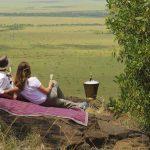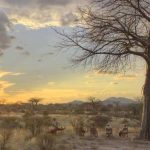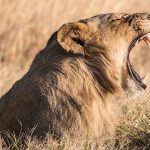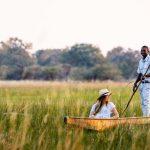The promised sands: could Madagascar be the new Maldives?
A much-anticipated island resort hopes to pioneer a new type of indulgent but adventurous beach break Arriving on Manamphao, one of the islands of the Nosy Ankao group by Sophy Roberts From the glass bubble of the helicopter, Madagascar’s Emerald Sea looks like a giant oyster shell. Where the water is shallow, the pale sand has the cast of mother-of-pearl, but where the lagoon tips over an underwater lip, the electric blue darkens to a fathomless black. Kite-surfers like the winds here, but otherwise boats are rare, the matchstick outriggers with delicate sails oddly reminiscent of the egrets that pass on the wing.
We fly lower over the mangroves and I notice the back of a turtle in the water. On another beach, as long as any I’ve seen, five locals are dipping their toes into the surf. I start to find my context. This swath of Madagascar’s north-east coast hasn’t the green fecundity of the Seychelles, nor the resort developments of Mauritius, which stud the land with swimming pools. But it has enthralling variety, which comes to life in this 30-minute helicopter journey hugging the shoreline as we travel south from Antsiranana, where there’s an international airport.
I’m heading for the Nosy Ankao archipelago, which at its closest point lies 3.5km off the mainland, to get the measure of Miavana — one of the most eagerly anticipated hotel openings of 2017. “A fisherman goes as deep as he can into a remote area, and casts as far as he can because he believes there are fish out there in the honeypot,” says Miavana’s developer Thierry Dalais, 58, who is piloting the helicopter. “I’m not a very good fisherman, but that’s the point of this place. Madagascar is the honeypot at the edge of the world.” Dalais has settled on a compelling, if complicated, spot. Madagascar has beaches, mountains and tropical rainforests, few tourists and abundant and distinctive wildlife. The biodiversity and the fact that about 90 per cent of species are endemic are the result of millions of years of isolation since the island split from Africa and India — it is sometimes referred to as the “eighth continent”. But it also suffers from a poor road network, unreliable domestic flights, environmental degradation (most importantly as a result of logging and soil erosion), and an inconsistent political record, with the last presidential coup as recent as 2009.
We fly over a black channel, which from July to September attracts whales, then the white-sand beaches and wooded core of Nosy Ankao come into view. There is just one problem — the resort isn’t quite ready. I was due to be one of the first guests, just ahead of the Christmas opening, but the launch has been pushed back to the end of April so I can only scope out the potential while staying in one of 14 (unfinished) villas that share 5km of unbroken white beach. “This could be the Mustique of the Indian Ocean,” says Dalais, citing the island colony of villas a Scottish baron created in the 1960s in the Caribbean, where everyone from Princess Margaret to Mick Jagger bought up real estate. One can’t fault Miavana’s ambition. Dalais and two minority partners, including a Malagasy, lease the majority of land on three islands in this archipelago (excluding state-protected forest, bird-breeding grounds and a historic lighthouse), where for the past three years a team of 100 landscapers has successfully removed 10,000 casuarina trees, and planted 60,000 endemics. The islands include Manamphao — “the statement piece, the Tiffany jewel,” says Dalais of this relatively small, 60-hectare island with outcrops that could be in Brittany, the rock dusted with froth and spume, an interior bristling with tussock grass, and a spectacular, half-curl spit of beach as squashy as white marshmallows. From June to September it’s a significant breeding site for Indian Ocean terns. In this early phase, Manamphao is going to be used for picnics, sleep-outs, and hiking. The plan for Ratsy, another of the islands, is to turn it into the Mnemba of Madagascar, says Dalais, referring to a well-loved Zanzibar private island lodge with hammocks and foot-in-the-sand houses. For now, however, the focus is on rehabilitating 360ha of Nosy Ankao itself, where I’m staying. “The Maldives are little dots with very intense hotels,” says Dalais, “but it doesn’t have this kind of largesse,” he says, gesturing at Nosy Ankao’s long beach where later that evening, a turtle comes in to lay its eggs. “In a week, or two weeks here, I don’t get to do the same thing twice.
This is a place for the adventurer in me.” Mark Carnegie, an Australian entrepreneur who sits on the board of the foundation overseeing Miavana’s conservation efforts, describes the area’s attractions another way: “Madagascar is such a weird-ass place. I mean how many places on earth have a moth with a 20cm tongue?” Protecting unique species will be a key goal for the operation, which will help fund the policing of sustainable fishing policies across a 15,000ha protected marine area. But in a country in which, according to the most recent World Bank data, 78 per cent of the population live below the poverty line (on less than $1.90 per day), just as important will be to convince locals of the value of tourism, as a source of employment and in a wider national context, as an alternative to logging. Dalais knows how he must appear — the Miavana-branded helicopter and the hotel’s $2,500-per-person-per-night room rate. “We look like fat cats,” he admits. “[The Malagasy] need to see the benefit, from the beginning, in real terms.” In fact, Dalais first came here in 2009 with neither hospitality nor environmental protection in mind but as an investor in an algae farm. Once dried, the algae could be used in cosmetic and food products, but despite waters rich in nutrients, problems with parasites and repeated crop failures meant the project was wound up in 2015. Dalais turned his attention to tourism, employing many of the farm staff to help create Miavana. Tourism is a sector Dalais knows well. In the late 1990s, his family became one of the five original investors in North Island in The Seychelles, a €3,000-per-person-per-night private island which has been widely praised for its environmental achievements (including eradicating a non-endemic rat population and supporting endangered bird species). That was sold in 2010 and the following year the family bought Norman Carr Safaris, among Africa’s most well regarded walking safari companies. Time and Tide, the family company, now has two safari operations in Zambia and plenty to occupy them, but it’s not hard to see why they were tempted to branch out to Madagascar.
In a visit of a couple of days, I watch a school of Bumphead parrotfish dance close to the shore outside my villa, snorkel in a pretty coral garden, and go for walks along the beach of Manamphao, where shells sit like shipwrecked jewels in the tideline. At present there are none of Madagascar’s famous lemurs on the island (there are ambitions to introduce them), but I see them on the mainland. It is the helicopter safaris, though, that bring this landscape alive in all that crazy variety which gives Madagascar the edge on any of its competitors. “Adventure flying blows open this area,” says Dalais, who has bought two Robinson R66s to bypass the roads and so give Miavana’s guests a shortcut to the mountains and rainforests. As we swoop over one mainland forest, I marvel at the ancient, tallest, trees, that reach up out of the canopy. We fly on to visit the vast tsingy — strange upright rock formations — of Ankarana National Park, where we walk deep into hidden cave systems crowded with bats. As to the hotel itself, even at this incomplete stage, the one-, two- and three-bedroom villas designed by Silvio Rech and Lesley Carstens seem a clear attempt to outdo their celebrated work on North Island. Rather than revisit its elegantly rustic look, the aesthetic is boldly modern, comprised of low-lying, flat-roofed Mies van der Rohe-style villas with glass frontage, utilising hand-cut stone and steel. Floors are a recycled waste wood composite; the air-conditioning is limited to a “breeze” that flutters over beds. I think the villas are positioned a little too close to each other when there’s such a vast amount of space but this will be less apparent when the new vegetation beds in. As for the main communal area, it’s on a grand scale, dominated by a 25-metre pool and a vaulted restaurant. Key staff are obvious pros: a South African chef, a Sri Lankan butler, a South African helicopter pilot who spends every free minute fishing. He does it on the fly, off the beach, catching giant trevally and barracuda (all catch and release, up to 25kg a piece). Flying over the mainland on a helicopter safari © Sophy Roberts “Madagascar is an immensely complicated part of the world,” says Carnegie, discussing the difficulties of Malagasy bureaucracy, and the transport logistics the developers have put in place to keep the construction moving. Half jokingly, Carnegie refers to Dalais as “King Julien” after the lemur king in the Hollywood animated movie, Madagascar, whose signature track is the catchy dance hit, “I like to move it (move it)”. Yes, Miavana is running later than hoped, but when it does open there won’t be anything quite like it. The legacy, however, needs to be more than a place to chill. Its deeper success will lie in how locals come to regard luxury tourism as the money starts coming in, how inclusive the project proves with the community, and how successful the developers’ rehabilitation of the land. They need to attract the next Mustique crowd to the islands but at the same time, to lure the lemurs there too.






